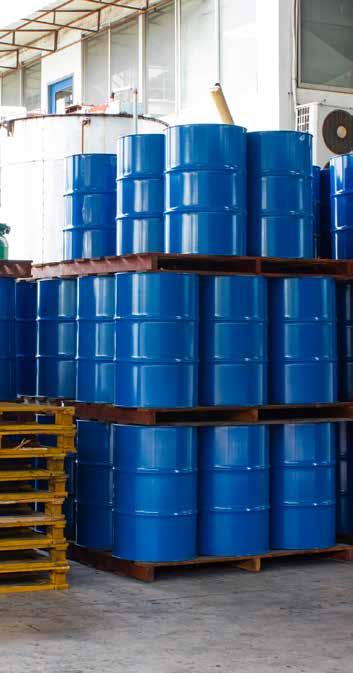
8 minute read
2.2 MODERNIZATION PROJECT PILLARS
A. UPSTREAM INVESTMENT ATTRACTION PILLAR
The program main objectives are developing an attractive environment for foreign investment, reducing bid round cycles & improving evaluation efficiency, streamlining current Bid Round processes, improving the current Model Agreement and expanding concession agreement portfolio.
Advertisement
It is worth noting that among the most important updates concerning the first pillar is launching Egypt’s Upstream
Gateway (EUG) tender as Egypt’s first E&O digital data bank to preserve the data and promote the country’s resources.
B. SECTOR STRUCTUR REFORM PILLAR
The project’s second pillar aims to set the roles of policymaking, regulatory oversight and operational responsibilities to be assigned to independent entities. It emphasizes improving business practices, performance, and transparency in Egypt’s oil and gas sector.
C. HUMAN RESOURCES (HR) MANAGEMENT PILLAR
The Modernization Project’s third pillar aims to maximize the efficiency of human capital in the sector. The targeted level of efficiency can be achieved through promoting new administrative system to develop the employees, prepare potential future leaders, and set a mechanism to uncover talented individuals. An important part of the HR management pillar was Zohr’s development program that started in August 2017 with 35,122 total participants, 287,874 training hours, and 74,695 as a total participation.
As an important part of the pillar’s updates, the MoP initiated the success story or the “action plan”. Executing the action plan for each company across the sector depends on the pillar’s commitment towards its objectives and the sector’s willingness to embrace change. In addition, the MoP conducted a statistical analysis on retirements within five years from 2019 to 2023.
The fourth pillar focuses on increasing energy efficiency across the value chain and improving the operating conditions. The pillar includes two programs which are; two programs, which are: Downstream Performance and Energy Efficiency. The Downstream Performance program objectives include increasing asset utilization and resource integration and achieving globally competitive cost performance. Meanwhile, the Energy Efficiency program focuses on improving energy efficiency across the sector.

E. UPSTREAM PERFORMANCE PILLAR
The fifth pillar targets promoting and increasing oil and gas production, minimizing costs, and focusing on lean operations by increasing oil and gas production and pipeline of proven reserves. In addition to, improving recovery rates and cost performance through world-class technology.
The upstream pillar targets providing technical support to the sector’s companies. Teams were built to provide this support permanently to improve efficiency and adopt new technologies. These teams include Asset Integrity, Artificial Lift and Operational Energy Efficiency.
In 2018, Asset Integrity teams delivered Management of Change (MOC) and Risk Assessment Management (RAMS) guidelines, The pillar further aims to upgrade performance of the upstream sector through minimizing new explorations costs. As part of the pillar, the program’s team works on holding several workshops periodically in order to exchange experiences among the companies.
to be published in 2019. In addition, a unified analysis for database for artificial lift was conducted and some KPI’S will be set.
Concerning the operational energy efficiency, Overhead Transmission Line (OHTL) guideline was prepared and is under finalization for publishing.
F. OIL AND GAS HUB STRATEGY PILLAR
The modernization initiative sets a clear path for Egypt to leverage its position in the global market as a regional energy hub.
The government started focusing on setting a plan for transforming Egypt into a regional energy hub, taking into account the importance of Egypt’s oil and gas infrastructure. The regional hub strategy works on three main dimensions, which are internal, political, technical, and commercial. An important initiative towards achieving the aims of the internal dimension was appointing a government committee to include all concerned bodies for joint coordination.
I. INTERNAL
Formation of the Governmental Committee:
The formation of a governmental committee comprising all concerned parties to study the project of transforming Egypt into a regional hub for energy trading, and developing a plan to achieve this goal.
Gas Market Reforms: • Issuing the Gas Market Regulatory Law in August 2017 and its executive regulation in February 2018. • Establishing a separate entity to organize the gas market in accordance to the law, and set its first meeting for its board of directors in February 2018.
•Setting a methodology to organize the network usage tariff and the technical controls for its operation. • Issuing the licenses of qualified suppliers and consumers to ensure that the market is fairly open and transparent to all parties.
Modernization Project: • Setting a vision for the sector that includes “transforming Egypt into a regional oil and gas hub” as one of its objectives. • Choosing a working team to prepare a strategy for transforming Egypt into a regional hub with the help of global consultants.

II. POLITICAL
First: Cooperation with the EU • Starting a strategic gas dialogue with the European Union (EU) and raising the discussions to the ministerial level. • Signing a Memorandum of Understanding (MoU) on the Strategic Energy Partnership in April 2018 during the EU energy and climate commissioner’s visit to Egypt.
Second: Cooperation with the Eastern Mediterranean Countries • Establishing the East Mediterranean Gas Forum (EMGF), based in Cairo, which includes the gas producing and importing countries and the transit countries in the Eastern Mediterranean. • The first Ministerial Conference of the Forum was held in Cairo on 14 and 15 January 2018.
Third: Cooperation with Cyprus: • A governmental agreement was signed in September 2018 to establish a direct pipeline from Aphrodite field to the Egyptian territories.
Fourth: Cooperation with Greece: • A tripartite summit was held between Egypt, Cyprus and Greece. All cooperation with Greece in the various fields of the oil and gas industry is under discussion, and the possibility of further trade agreements has been provided. Fifth: Cooperation with Jordan: • The Egyptian Jordanian cooperation was recently developed through importing natural gas to Jordon. The integration of existing natural gas reception facilities in Aqaba and Ain Sokhna to ensure supplies and sustainability. • Signing an MoU with the Jordanian side in April 2017 to cooperate in the field of energy in general and natural gas in particular. • Signing an MoU between Egypt and Jordan in October 2018 to enhance cooperation in the field of training and exchange of expertise in the field of natural gas industry and to benefit from the training centers of the Egyptian petroleum sector companies. • In January 2019, MoUs were signed between the natural gas companies in both countries, which regulate the sale and purchase of natural gas in addition to the participation of companies in the Egyptian petroleum sector in the implementation of gas delivery projects inside Jordan.
Sixth: cooperation with Iraq: • Signing an MoU between Egypt, Jordan and Iraq to transport Iraqi natural gas and crude oil to Egypt via Jordan.


III. TECHNICAL & COMMERCIAL
A. Making full use of the Eastern Mediterranean Gas Fields: • Preparing proposals for the best routes for linking the Eastern Mediterranean fields to Egypt, using existing natural gas pipelines to liquefaction units in Damietta and Idku. • The Egyptian private sector contracted to transfer gas from Israeli fields to Egypt as an important step towards the exploitation of the East Mediterranean natural gas and transforming Egypt into a regional energy hub.
B. Regional Hub’s Development Projects:
1. Petroleum Products Trade and Storage Project and the establishment of a new pier at El Sokhna Port • A 2,500 meter pier with three berths for receiving FSRUs and petroleum products tankers. • Onshore and offshore facilities for storage and handling Gas, Fuel Oil and LPG.

Project implementation stages:
Phase I: FSRU and petroleum products tankers berth were completed in April 2017, in addition to marine anchors for product transporters.
Phase II: LPG Storage, handling & transportation facilities, completed in December 2017.
Phase III: Fuel Oil handling & transportation facilities and floating roof storage tanks, expected to be completed in March 2019.
2. Sonker Bunkering Company’s project at Sokhna Port
•Establishment of a berth to receive and trade various petroleum products (Gasoline, Gas Oil and LPG). • Construction of a new Terminal for the storage of petroleum products in the port of Sokhna.
3. Hamra Port Development Project • A major project for the expansion of Hamra Port at the Mediterranean and upgrade the SBM and Farm tanks to receive larger tanks up to 1.0 mmb.
4. Port Sidi Kerir Port Upgrade Project • Upgrade of Sidi Kerir Port to receive and handle Gas Oil for the first time.

G. DECISION SUPPORT AND DATA FLOW PILLAR
The seventh pillar of the modernization project mainly targets developing an ICT strategy to achieve business-ICT alignment and provide context for ICT investment priorities. In addition, it aims at developing an ERP plan to manage petroleum sector resources and assets, creating an official gateway to streamline communication and collaboration among sector employees and Initiating sector-wide connectivity implementation to achieve dataflow. The objectives of this pillar include building a reliable and precise decision support system to support MoP, SOEs, and companies’ decisions.
The ICT strategy facilitates realization of sector’s vision through alignment the ICT strategy with the business strategy using latest digitization and automation industrial standards. On the other hand, the new ICT Strategy enables the small and medium companies to have a benchmark to build their technological environment. In addition, it is a baseline for larger entities to build over and ensure the best for the business and the industry.
The sector’s ICT strategy is considered as a gateway towards unifying policies and laying out a standard for all sector entities. Moreover, this strategy targets putting the country’s and investments’ security into consideration.










